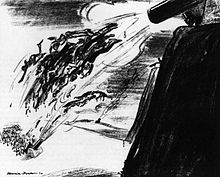- Maurice Becker
-
Maurice Becker (1889–1975) was a radical political artist best known for his work in the 1910s and 1920s for such publications as The Masses and The Liberator.
Contents
Biography
Early years
Maurice Becker was born in Nizhni-Novgorod, Russia, the son of ethnic Jewish parents. The family emigrated from Russia to the United States in 1892, moving to the Jewish community of the Lower East Side of New York City. His older sister was Helen Tamiris a modern dance pioneer and his brother Sam Becker was a sculptor.
The young Maurice took night classes in bookkeeping and art while working days as a sign painter.[1] He worked as an artist for the New York Tribune from 1914 to 1915, and for the Scripps newspapers from 1915 to 1918. He also contribute artwork on a freelance basis to a broad range of contemporary publications, including Harper's Weekly, Metropolitan magazine, and The Saturday Evening Post.[2]
Radical art
 Becker cartoon published in The Masses, March 1913.
Becker cartoon published in The Masses, March 1913.
Maurice Becker is best remembered as an illustrator for radical magazines, most famously for the New York political and artistic magazine The Masses, to which he began to contribute in 1912.
He married Dorothy Baldwin, an active Socialist, in 1918. That same year he became a conscientious objector to American participation in World War I. He fled to Mexico to avoid the draft.[3] He was arrested upon his return to the United States in 1919 and was tried, convicted, and sentenced to 25 years of hard labor, of which he served 4 months at Fort Leavenworth prior to commutation of his sentence.[4]
Becker was a frequent contributor to the radical press, publishing his art in such periodicals as Revolt, The Toiler, New Solidarity, The Blast, Survey Graphic, The New York Call. and The New Masses. Becker's work, which often made use of the muted tones of graphite or charcoal, was likewise generally softer in political tone than the more hard-edged and biting work of his peers, who included Art Young, Fred Ellis, Robert Minor, Hugo Gellert, and William Gropper.
From 1921 to 1923, Becker lived in Mexico, where he worked as an artist for El Pulsa de México, an English-language magazine. After that time, he dedicated himself to painting full time, essentially ending his career as a political artist for magazines. He did occasionally contribute art to political publications after that date, however, such as an apolitical drawing entitled "Summer," which ran in the August 1926 issue of The New Masses.
Becker remained a political radical throughout his life and was either a member or a fellow traveler of the Communist Party USA for many years. He visited the Soviet Union in 1931. In 1932 Becker Joined The League of Professional Groups for Foster and Ford, officially endorsing Communist candidate William Z. Foster for President of the United States.[5] In 1936 he likewise endorsed Communist candidate Earl Browder as a member of the Committee of Professional Groups for Browder and Ford.[6] His name appeared on the letterhead of the Artists' Front to Win the War, a mass organization closely linked to the Communist Party, and he was a signatory to the call for formation of the American Artists' Congress, a party-backed initiative.[7]
Maurice Becker died in 1975.
Footnotes
- ^ Rebecca Zurier, Art for the Masses: A Radical Magazine and Its Graphics, 1911-1917. Philadelphia: Temple University Press, 1988. Page 175.
- ^ Zurier, Art for the Masses, pg. 176.
- ^ Zurier, Art for the Masses, pg. 176.
- ^ Zurier, Art for the Masses, pg. 176.
- ^ Special Committee on Un-American Activities, House of Representatives, Investigation of Un-American Propaganda Activities in the United States: Appendix — Part IX, pg. 1000.
- ^ HUAC, Appendix — Part IX, pg. 641.
- ^ HUAC, Appendix — Part IX, pp. 574, 1075.
External resources
- Smithsonian Institution: Maurice Becker Papers
- Comrades in Art: Maurice Becker
Categories:- American socialists
- American cartoonists
- American painters
- 1889 births
- 1975 deaths
- Russian Jews
Wikimedia Foundation. 2010.

